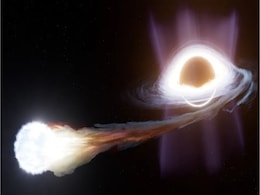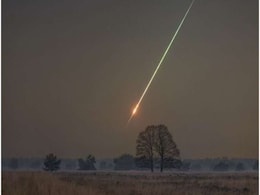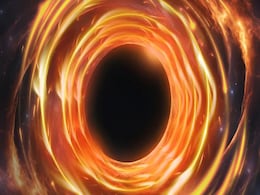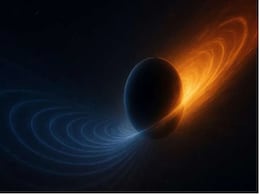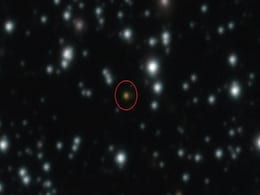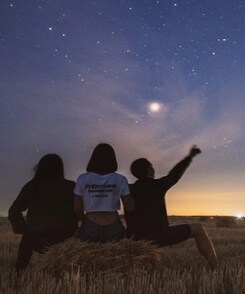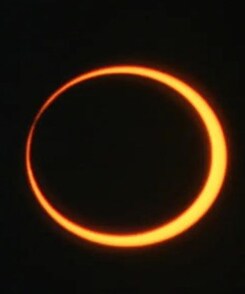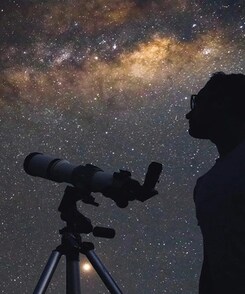Astronomical Event
- All
- News
- Web Stories
-

Astronomers Observe Black Hole Twisting Spacetime for the First Time, Confirming Einstein’s Theory
- Friday December 19, 2025
- Written by Gadgets 360 Staff
Astronomers have directly observed a black hole twisting spacetime for the first time, confirming Einstein’s long-standing prediction. The effect was detected during a violent stellar destruction event, where repeating X-ray and radio signals revealed a slow cosmic wobble. The discovery provides new insight into black hole spin, jets, and extreme...
-
 www.gadgets360.com
www.gadgets360.com
-

Longest Solar Eclipse In 100 Years Is Coming. Here's Where You'll See It
- Friday December 12, 2025
- Science | Edited by Nikhil Pandey
Astronomers worldwide are preparing for a rare total solar eclipse on August 2, 2027, with a peak totality of about 6 minutes and 23 seconds.
-
 www.ndtv.com
www.ndtv.com
-

JWST Detects Oldest Supernova Ever Seen, Linked to GRB 250314A
- Friday December 12, 2025
- Written by Gadgets 360 Staff
Astronomers using the James Webb Space Telescope have detected the oldest supernova ever recorded, tied to gamma-ray burst GRB 250314A. Occurring when the universe was only 730 million years old, the explosion provides a rare glimpse into the first generations of stars and early galaxy growth, highlighting Webb’s unmatched ability to study the di...
-
 www.gadgets360.com
www.gadgets360.com
-

Astronomers Spot the Longest Gamma-Ray Burst Ever Seen: What You Need to Know
- Wednesday December 10, 2025
- Written by Gadgets 360 Staff
A powerful gamma-ray burst detected in July 2025 has stunned astronomers by lasting nearly seven hours, making it the longest GRB ever recorded. Named GRB 250702B, the event produced repeated pulses and unusual afterglows, raising theories about rare “middleweight” black holes tearing apart stars in deep space.
-
 www.gadgets360.com
www.gadgets360.com
-

Misaligned Exoplanet Is Challenging How We Think Solar Systems Form
- Friday December 5, 2025
- Written by Gadgets 360 Staff
Astronomers studying the dwarf-star system TOI-3884b have uncovered a striking anomaly: the planet’s orbit is sharply misaligned with its star’s rotation. Using multicolour transit observations, researchers detected repeated starspot-crossing events that revealed the planet passes over cooler regions on the stellar surface. Follow-up monitoring...
-
 www.gadgets360.com
www.gadgets360.com
-

2027 Solar Eclipse To Bring Longest Darkness Of The Century
- Tuesday November 25, 2025
- Science | Edited by Nikhil Pandey
A rare total solar eclipse on 2 August 2027 will plunge parts of Europe, North Africa and the Middle East into darkness for up to 6 minutes.
-
 www.ndtv.com
www.ndtv.com
-

Astronomers Record First-Ever Massive Stellar Blast Capable Of Stripping Planetary Atmospheres
- Saturday November 22, 2025
- Science | Edited by Astitva Raj
This event originated from a red dwarf star, which is much dimmer, cooler, and smaller than the Sun.
-
 www.ndtv.com
www.ndtv.com
-

Hubble Observes Massive Stellar Eruption from EK Draconis, Hinting at Life’s Origins
- Sunday November 2, 2025
- Written by Gadgets 360 Staff
Astronomers using the Hubble Space Telescope observed a huge solar storm from EK Draconis, a young Sun-like star. The eruption’s energy may trigger atmospheric chemistry, forming greenhouse gases and organic molecules. Such events could mirror early solar activity that helped spark life on ancient Earth and distant exoplanets.
-
 www.gadgets360.com
www.gadgets360.com
-

Black Hole Tears Star Apart, Sends Out Powerful Flares Six Months Later
- Friday October 17, 2025
- Written by Gadgets 360 Staff
Astronomers detected a black hole 650 million light-years away devouring a star and then erupting twice with powerful flares months later. Observed by the Zwicky Transient Facility and tracked by ALMA and the VLA, this rare off-centre event hints at a rogue black hole cast out from its host galaxy.
-
 www.gadgets360.com
www.gadgets360.com
-

Tiny Asteroid 2025 TF Zooms Past Earth Undetected, Closer Than Satellites
- Tuesday October 7, 2025
- Written by Gadgets 360 Staff
A small asteroid named 2025 TF surprised astronomers after flying only 265 miles above Antarctica, lower than many satellites. Detected post-passage by ESA, it underscores the challenge of spotting small, fast-moving space rocks before they come close to Earth.
-
 www.gadgets360.com
www.gadgets360.com
-

Astronomers Reveal Sudden Explosion of Small Asteroid Over France
- Thursday September 18, 2025
- Written by Gadgets 360 Staff
In February 2023, asteroid 2023 CX1 exploded suddenly over France, stunning scientists. Tracked only hours before impact, the tiny rock disintegrated in a powerful airburst, scattering meteorites across Normandy. The rare event provides crucial insights into asteroid behavior and raises new considerations for future planetary defense strategies.
-
 www.gadgets360.com
www.gadgets360.com
-

Astronomers Predict 90 Percent Chance of Spotting an Exploding Black Hole in Next Decade
- Saturday September 13, 2025
- Written by Gadgets 360 Staff
Astronomers now predict a 90% chance of detecting an exploding primordial black hole within a decade. Such an event would confirm Stephen Hawking’s theory that black holes evaporate, releasing a flash of radiation and exotic particles. Detecting one would revolutionize physics and rewrite our understanding of the universe.
-
 www.gadgets360.com
www.gadgets360.com
-

Black Hole Kicked Away? Gravitational Waves Reveal Einstein’s Ripples in Spacetime
- Saturday September 13, 2025
- Written by Gadgets 360 Staff
Astronomers have, for the first time, measured the recoil speed and direction of a newborn black hole using gravitational waves. Data from the 2019 event GW190412 revealed the remnant shot away at 50 km/s. This breakthrough shows gravitational waves can reconstruct full 3D motion, offering new ways to connect black hole mergers with light signals.
-
 www.gadgets360.com
www.gadgets360.com
-

NASA Detects Strange Gamma-Ray Burst That Defies 50 Years of Expectations
- Thursday September 11, 2025
- Written by Gadgets 360 Staff
Astronomers have spotted GRB 250702B, a gamma-ray burst that erupted several times over two days—something never seen before. Detected by NASA’s Fermi and China’s Einstein Probe, the event defies current models of collapsing stars or black holes, hinting at an entirely new cosmic phenomenon.
-
 www.gadgets360.com
www.gadgets360.com
-

Astronomers Observe Black Hole Twisting Spacetime for the First Time, Confirming Einstein’s Theory
- Friday December 19, 2025
- Written by Gadgets 360 Staff
Astronomers have directly observed a black hole twisting spacetime for the first time, confirming Einstein’s long-standing prediction. The effect was detected during a violent stellar destruction event, where repeating X-ray and radio signals revealed a slow cosmic wobble. The discovery provides new insight into black hole spin, jets, and extreme...
-
 www.gadgets360.com
www.gadgets360.com
-

Longest Solar Eclipse In 100 Years Is Coming. Here's Where You'll See It
- Friday December 12, 2025
- Science | Edited by Nikhil Pandey
Astronomers worldwide are preparing for a rare total solar eclipse on August 2, 2027, with a peak totality of about 6 minutes and 23 seconds.
-
 www.ndtv.com
www.ndtv.com
-

JWST Detects Oldest Supernova Ever Seen, Linked to GRB 250314A
- Friday December 12, 2025
- Written by Gadgets 360 Staff
Astronomers using the James Webb Space Telescope have detected the oldest supernova ever recorded, tied to gamma-ray burst GRB 250314A. Occurring when the universe was only 730 million years old, the explosion provides a rare glimpse into the first generations of stars and early galaxy growth, highlighting Webb’s unmatched ability to study the di...
-
 www.gadgets360.com
www.gadgets360.com
-

Astronomers Spot the Longest Gamma-Ray Burst Ever Seen: What You Need to Know
- Wednesday December 10, 2025
- Written by Gadgets 360 Staff
A powerful gamma-ray burst detected in July 2025 has stunned astronomers by lasting nearly seven hours, making it the longest GRB ever recorded. Named GRB 250702B, the event produced repeated pulses and unusual afterglows, raising theories about rare “middleweight” black holes tearing apart stars in deep space.
-
 www.gadgets360.com
www.gadgets360.com
-

Misaligned Exoplanet Is Challenging How We Think Solar Systems Form
- Friday December 5, 2025
- Written by Gadgets 360 Staff
Astronomers studying the dwarf-star system TOI-3884b have uncovered a striking anomaly: the planet’s orbit is sharply misaligned with its star’s rotation. Using multicolour transit observations, researchers detected repeated starspot-crossing events that revealed the planet passes over cooler regions on the stellar surface. Follow-up monitoring...
-
 www.gadgets360.com
www.gadgets360.com
-

2027 Solar Eclipse To Bring Longest Darkness Of The Century
- Tuesday November 25, 2025
- Science | Edited by Nikhil Pandey
A rare total solar eclipse on 2 August 2027 will plunge parts of Europe, North Africa and the Middle East into darkness for up to 6 minutes.
-
 www.ndtv.com
www.ndtv.com
-

Astronomers Record First-Ever Massive Stellar Blast Capable Of Stripping Planetary Atmospheres
- Saturday November 22, 2025
- Science | Edited by Astitva Raj
This event originated from a red dwarf star, which is much dimmer, cooler, and smaller than the Sun.
-
 www.ndtv.com
www.ndtv.com
-

Hubble Observes Massive Stellar Eruption from EK Draconis, Hinting at Life’s Origins
- Sunday November 2, 2025
- Written by Gadgets 360 Staff
Astronomers using the Hubble Space Telescope observed a huge solar storm from EK Draconis, a young Sun-like star. The eruption’s energy may trigger atmospheric chemistry, forming greenhouse gases and organic molecules. Such events could mirror early solar activity that helped spark life on ancient Earth and distant exoplanets.
-
 www.gadgets360.com
www.gadgets360.com
-

Black Hole Tears Star Apart, Sends Out Powerful Flares Six Months Later
- Friday October 17, 2025
- Written by Gadgets 360 Staff
Astronomers detected a black hole 650 million light-years away devouring a star and then erupting twice with powerful flares months later. Observed by the Zwicky Transient Facility and tracked by ALMA and the VLA, this rare off-centre event hints at a rogue black hole cast out from its host galaxy.
-
 www.gadgets360.com
www.gadgets360.com
-

Tiny Asteroid 2025 TF Zooms Past Earth Undetected, Closer Than Satellites
- Tuesday October 7, 2025
- Written by Gadgets 360 Staff
A small asteroid named 2025 TF surprised astronomers after flying only 265 miles above Antarctica, lower than many satellites. Detected post-passage by ESA, it underscores the challenge of spotting small, fast-moving space rocks before they come close to Earth.
-
 www.gadgets360.com
www.gadgets360.com
-

Astronomers Reveal Sudden Explosion of Small Asteroid Over France
- Thursday September 18, 2025
- Written by Gadgets 360 Staff
In February 2023, asteroid 2023 CX1 exploded suddenly over France, stunning scientists. Tracked only hours before impact, the tiny rock disintegrated in a powerful airburst, scattering meteorites across Normandy. The rare event provides crucial insights into asteroid behavior and raises new considerations for future planetary defense strategies.
-
 www.gadgets360.com
www.gadgets360.com
-

Astronomers Predict 90 Percent Chance of Spotting an Exploding Black Hole in Next Decade
- Saturday September 13, 2025
- Written by Gadgets 360 Staff
Astronomers now predict a 90% chance of detecting an exploding primordial black hole within a decade. Such an event would confirm Stephen Hawking’s theory that black holes evaporate, releasing a flash of radiation and exotic particles. Detecting one would revolutionize physics and rewrite our understanding of the universe.
-
 www.gadgets360.com
www.gadgets360.com
-

Black Hole Kicked Away? Gravitational Waves Reveal Einstein’s Ripples in Spacetime
- Saturday September 13, 2025
- Written by Gadgets 360 Staff
Astronomers have, for the first time, measured the recoil speed and direction of a newborn black hole using gravitational waves. Data from the 2019 event GW190412 revealed the remnant shot away at 50 km/s. This breakthrough shows gravitational waves can reconstruct full 3D motion, offering new ways to connect black hole mergers with light signals.
-
 www.gadgets360.com
www.gadgets360.com
-

NASA Detects Strange Gamma-Ray Burst That Defies 50 Years of Expectations
- Thursday September 11, 2025
- Written by Gadgets 360 Staff
Astronomers have spotted GRB 250702B, a gamma-ray burst that erupted several times over two days—something never seen before. Detected by NASA’s Fermi and China’s Einstein Probe, the event defies current models of collapsing stars or black holes, hinting at an entirely new cosmic phenomenon.
-
 www.gadgets360.com
www.gadgets360.com









